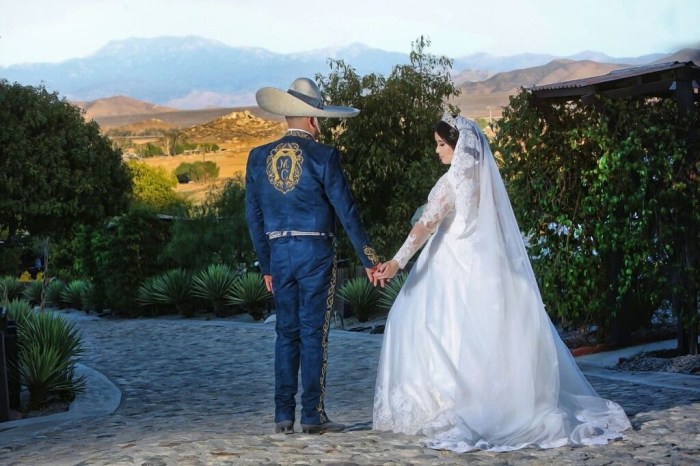Mexican-Inspired Wedding Dresses: A Blend of Tradition and Modernity: Mexican Inspired Wedding Dress

Source: strutbridalsalon.com
Mexican inspired wedding dress – Mexican-inspired wedding dresses offer a vibrant and unique alternative to traditional bridal styles. They seamlessly blend rich cultural heritage with contemporary design, resulting in gowns that are both stunning and meaningful. This exploration delves into the key elements that define this aesthetic, from fabric choices and silhouettes to embellishments and modern interpretations.
Defining “Mexican Inspired” in Wedding Dress Design, Mexican inspired wedding dress
A Mexican-inspired wedding dress draws inspiration from the diverse textile traditions, vibrant colors, and symbolic patterns of Mexico. Designs often incorporate elements reminiscent of traditional Mexican clothing, such as embroidered details, flowing silhouettes, and the use of rich, saturated colors. Regional variations significantly impact the final aesthetic; for example, dresses inspired by Oaxaca might feature intricate embroidery and bold colors, while those inspired by Yucatan might showcase lighter fabrics and more delicate embellishments.
The historical influence of indigenous artistry and colonial styles is also evident in many designs, creating a unique blend of historical and modern elements.
Fabric and Textile Choices
The choice of fabric significantly impacts the overall look and feel of a Mexican-inspired wedding dress. While luxurious fabrics like silk and lace are often used for their drape and elegance, traditional Mexican textiles offer a unique opportunity to incorporate authentic cultural elements. Examples include brightly colored handwoven cotton, intricate embroidery on linen, or the use of “tejido” (woven fabrics) from different regions.
These choices influence the dress’s texture, weight, and overall aesthetic.
Mexican-inspired wedding dresses often feature vibrant colors and intricate embroidery, reflecting the rich cultural heritage. For a more modern take, consider incorporating elements like a delicate, flowing silhouette, perhaps even opting for a stunning lace dress open back wedding design. This allows for a beautiful balance of traditional inspiration and contemporary elegance, resulting in a truly unique and memorable bridal look.
| Fabric | Drape | Texture | Cost |
|---|---|---|---|
| Silk | Fluid and luxurious | Smooth and lustrous | High |
| Lace | Delicate and flowing | Intricate and airy | Medium to High |
| Handwoven Cotton | Moderate drape, depending on weave | Slightly rough, natural | Medium |
Silhouette and Style Variations
Mexican-inspired wedding dresses can encompass a variety of silhouettes, from the classic A-line to the more form-fitting mermaid or the dramatic ballgown. Traditional Mexican clothing, such as the flowing “huipil” or the fitted “rebozo,” can inspire modern adaptations in wedding dress design. Necklines, sleeve lengths, and train lengths also play a crucial role in shaping the overall aesthetic.
A high neckline might evoke a more traditional feel, while a plunging neckline can create a more modern look.
Example Silhouettes: 1. A flowing A-line gown with a fitted bodice, embroidered with floral motifs reminiscent of traditional Mexican textiles. 2. A mermaid silhouette dress featuring a deep V-neckline and a long train, embellished with delicate lace inspired by colonial-era designs. 3.
A ballgown silhouette with a full skirt made of layered handwoven cotton, adorned with vibrant embroidery and a ruffled neckline.
Embellishments and Accessories
Intricate embroidery, beading, and lace are commonly used to create authentic Mexican-inspired details. Traditional Mexican embroidery patterns, often featuring vibrant floral motifs, animals, or geometric designs, carry symbolic meanings and add a layer of cultural significance. Accessories like elaborate veils, intricately designed headpieces, and handcrafted jewelry further enhance the overall aesthetic. These details should complement the dress’s design and create a cohesive and culturally rich look.
- Floral Embroidery: Intricate hand-stitched embroidery using vibrant threads, depicting traditional Mexican flora.
- Mirror Work: Small, intricately placed mirrors, a common element in traditional Mexican clothing, adding sparkle and texture.
- Beading: Delicate beading along the neckline or hemline, creating subtle shimmer and detail.
- Lace Appliqués: Using lace inspired by traditional Mexican designs, adding a touch of elegance and sophistication.
- Ribbon Details: Incorporating colorful ribbons in traditional Mexican patterns, creating a playful and festive touch.
Modern Interpretations and Trends
Modern designers are creatively incorporating Mexican-inspired elements into contemporary wedding dress designs, resulting in gowns that are both stylish and culturally relevant. This fusion often involves blending traditional aesthetics with modern trends in bridal fashion, creating a unique and personalized look for the bride.
- Bold Color Palettes: Incorporating rich jewel tones and vibrant hues beyond traditional white.
- Asymmetrical Designs: Modernizing traditional silhouettes with asymmetrical necklines or hemlines.
- Minimalist Embroidery: Using strategically placed embroidery to highlight key areas of the dress.
FAQs
What is the average price range for a Mexican-inspired wedding dress?
The price varies greatly depending on the designer, fabrics, and embellishments. Expect a range from a few hundred dollars to several thousand.
Where can I find a designer specializing in Mexican-inspired wedding dresses?
Searching online directories of wedding dress designers, browsing bridal boutiques specializing in unique styles, and contacting designers directly are good starting points.
Can I incorporate Mexican-inspired elements into a dress that isn’t entirely Mexican-themed?
Absolutely! You can add subtle details like embroidery, a specific color palette, or a unique neckline for a touch of Mexican flair.
Are there specific ethical considerations when choosing fabrics and materials for a Mexican-inspired dress?
Yes, consider sourcing ethically produced fabrics and supporting artisans who uphold fair labor practices. Look for certifications or research brands committed to sustainability.
